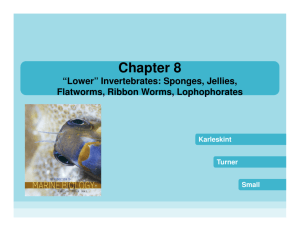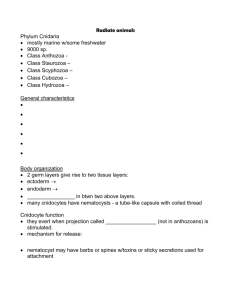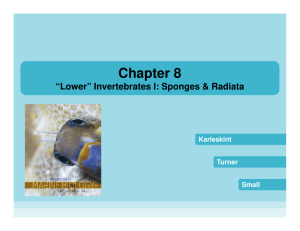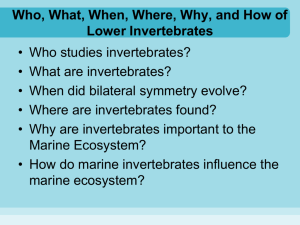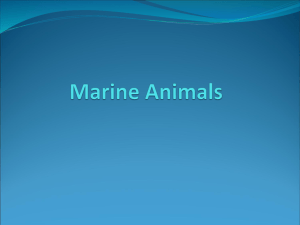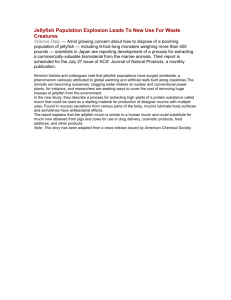Sponges & Cnidarians Lab Manual: Anatomy, Behavior, Ecology
advertisement
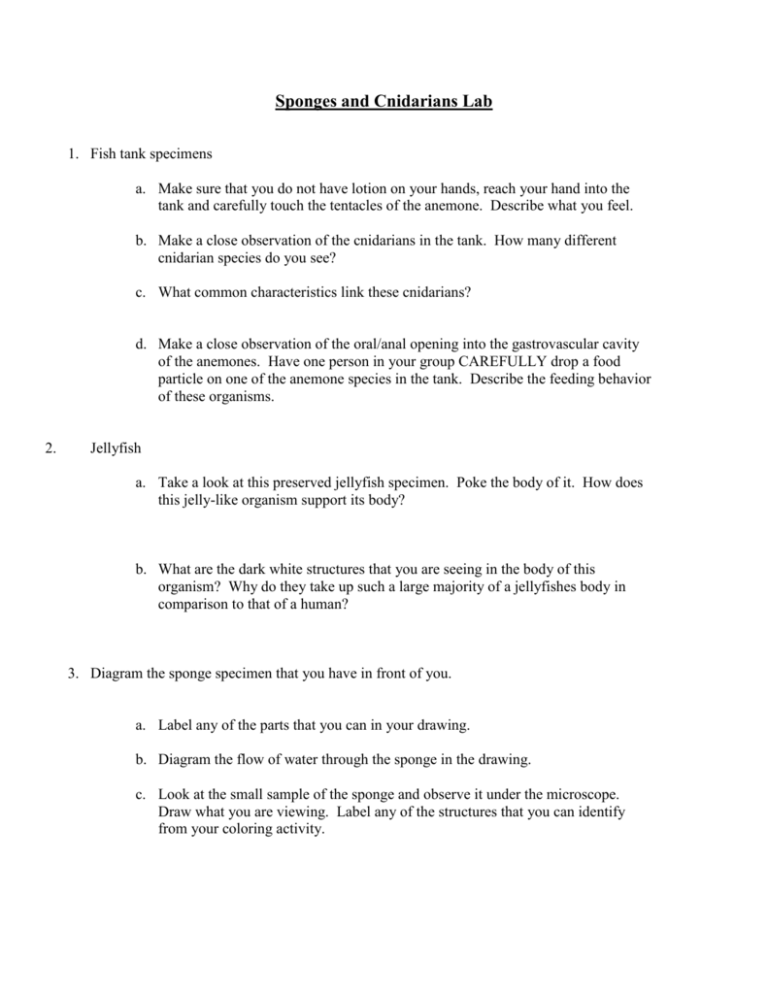
Sponges and Cnidarians Lab 1. Fish tank specimens a. Make sure that you do not have lotion on your hands, reach your hand into the tank and carefully touch the tentacles of the anemone. Describe what you feel. b. Make a close observation of the cnidarians in the tank. How many different cnidarian species do you see? c. What common characteristics link these cnidarians? d. Make a close observation of the oral/anal opening into the gastrovascular cavity of the anemones. Have one person in your group CAREFULLY drop a food particle on one of the anemone species in the tank. Describe the feeding behavior of these organisms. 2. Jellyfish a. Take a look at this preserved jellyfish specimen. Poke the body of it. How does this jelly-like organism support its body? b. What are the dark white structures that you are seeing in the body of this organism? Why do they take up such a large majority of a jellyfishes body in comparison to that of a human? 3. Diagram the sponge specimen that you have in front of you. a. Label any of the parts that you can in your drawing. b. Diagram the flow of water through the sponge in the drawing. c. Look at the small sample of the sponge and observe it under the microscope. Draw what you are viewing. Label any of the structures that you can identify from your coloring activity. 4. Gonionemous a. Draw the specimen. b. What key tissues found in these organisms helps separate cnidarians from sponges, making them active predators versus sessile filter feeders? Explain the function of these structures/tissues. 5. Obelia colony slide http://kentsimmons.uwinnipeg.ca/16cm05/16labman05/lb5pg4.htm a. This is a colony of obelia in their hydroid life-cycle stage. This organism is interesting because it lives a two-part life cycle. Part of its life it is a medusa, and part of its life it is a polyp. Draw an example of both life cycle stages below. b. On your picture of the medusa life form, label the velum, the statoliths, the manubrium and the gonads. What is the function of the statoliths? 6. Mystery object in my fish tank. a. Take a close look at the underside of the rocks of the salt tank. Notice the odd objects growing on the rocks? What would you predict they are on first appearance? b. I was very curious about what they were myself…so I decided to take a look! Look at the specimen under the microscope. Make a quick sketch of your specimen below. c. What do you think we have growing in our tank? How did you come to this conclusion? d. Are they harmful to my tank? Should I scrape them off? Defend your reason. 7. Jellyfish articles. a. Jellyfish populations on the rise? With so many stories of declines in species diversity, it is uncommon to hear of organisms that are actually thriving in the current changing environment, but jellyfish are! Explain the current trend we are seeing in jellyfish populations. What factors are contributing to these observations? b. Name some reasons jellyfish blooms are considered bad. 8. Skeleton http://coralreef.noaa.gov/aboutcorals/coral101/anatomy/ a. What structure are you observing? What is this chemical composition of this structure? b. How fast on average do hard corals grow a year? c. What are the varying holes in this structure from? d. How do soft corals compare to hard corals? What structures do soft corals use for body support? 9. Video clip a. View the video of the cnidocyte in cnidarian bodies. Explain the action of this specialized cell and diagram its function below. b. Why is the cnidocyte a key evolutionary adaptation for these animals? 10. Ancient corals and sponges (http://www.paleoportal.org/index.php?globalnav=time_space&sectionnav=period&period_id= 13) a. Take a look at the two specimens at this station. Which one is an ancient coral and which is the ancient sponge? b. How old do you predict these fossils are? They are actually from the Devonian era. How long ago was this? c. These fossils can be found in Mason City, Iowa. They are actually quite common in this region! What did Iowa look like in the Devonian Era? What type of organisms were abundant?


